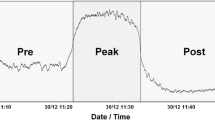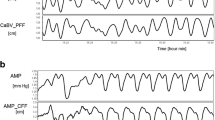Abstract
Background
This prospective study of an innovative non-invasive ultrasonic cerebrovascular autoregulation (CA) monitoring method is based on real-time measurements of intracranial blood volume (IBV) reactions following changes in arterial blood pressure. In this study, we aimed to determine the clinical applicability of a non-invasive CA monitoring method by performing a prospective comparative clinical study of simultaneous invasive and non-invasive CA monitoring on intensive care patients.
Methods
CA was monitored in 61 patients with severe traumatic brain injuries invasively by calculating the pressure reactivity index (PRx) and non-invasively by calculating the volumetric reactivity index (VRx) simultaneously. The PRx was calculated as a moving correlation coefficient between intracranial pressure and arterial blood pressure slow waves. The VRx was calculated as a moving correlation coefficient between arterial blood pressure and non-invasively-measured IBV slow waves.
Results
A linear regression between VRx and PRx averaged per patients’ monitoring session showed a significant correlation (r = 0.843, p < 0.001; 95% confidence interval 0.751 – 0.903). The standard deviation of the difference between VRx and PRx was 0.192; bias was − 0.065.
Conclusions
This prospective clinical study of the non-invasive ultrasonic volumetric reactivity index VRx monitoring, based on ultrasonic time-of-flight measurements of IBV dynamics, showed significant coincidence of non-invasive VRx index with invasive PRx index. The ultrasonic time-of-flight method reflects blood volume changes inside the acoustic path, which crosses both hemispheres of the brain. This method does not reflect locally and invasively-recorded intracranial pressure slow waves, but the autoregulatory reactions of both hemispheres of the brain. Therefore, VRx can be used as a non-invasive cerebrovascular autoregulation index in the same way as PRx and can also provide information about the CA status encompassing all intracranial hemodynamics.




Similar content being viewed by others
References
Paulson OB, Strandgaard S, Edvinsson L. Cerebral autoregulation. Cerebrovasc Brain Metab Rev. 1990;2:161–92.
Chillon JM, Baumbach GL. Autoregulation: arterial and intracranial pressure. In: Edvinsson L, Krause DN, editors. Cerebral blood flow and metabolism. 2nd ed. Philadelphia: Lippincott Williams & Wilkins; 2002. p. 395–412.
Sviri GE, Newell DW. Cerebral autoregulation following traumatic brain injury. Open Neurosurg J. 2010;3:6–9.
Czosnyka M, Brady K, Reinhard M, Smielewski P, Steiner LA. Monitoring of cerebrovascular autoregulation: facts, myths, and missing links. Neurocrit Care. 2009;10:373–86.
Czosnyka M, Smielewski P, Kirkpatrick P, Laing RG, Menon D, Pickard JD. Continuous assessment of the cerebral vasomotor reactivity in head injury. Neurosurgery. 1997;41:11–7.
Preiksaitis A, Krakauskaite S, Petkus V, et al. Association of severe traumatic brain injury patient outcomes with duration of cerebrovascular autoregulation impairment events. Neurosurgery. 2016;79:75–82.
Sorrentino EJ, Diedler J, Kasprowicz M, et al. Critical thresholds for cerebrovascular reactivity after traumatic brain injury. Neurocrit Care. 2012;16:258–66.
Aries MJH, Czosnyka M, Budohoski KP, et al. Continuous determination of optimal cerebral perfusion pressure in traumatic brain injury. Crit Care Med. 2012;40:2456–63.
Zweifel C, Lavinio A, Steiner LA, et al. Continuous monitoring of cerebrovascular pressure reactivity in patients with head injury. Neurosurg Focus. 2008;25:E2.
Depreitere B, Güiza F, Van den Berghe G, et al. Pressure autoregulation monitoring and cerebral perfusion pressure target recommendation in patients with severe traumatic brain injury based on minute-by-minute monitoring data. J Neurosurg. 2014;120:1451–7.
Le Roux P, Menon DK, Citerio G, et al. Consensus summary statement of the international multidisciplinary consensus conference on multimodality monitoring in neurocritical care: a statement for healthcare professionals from the Neurocritical Care Society and the European Society of Intensive Care Medicine. Neurocrit Care. 2014;40:1189–209.
Steiner LA, Czosnyka M, Piechnik SK, et al. Continuous monitoring of cerebrovascular pressure reactivity allows determination of optimal cerebral perfusion pressure in patients with traumatic brain injury. Crit Care Med. 2002;30:733–8.
Petkus V, Preiksaitis A, Krakauskaite S, et al. Benefit on optimal cerebral perfusion pressure targeted treatment for traumatic brain injury patients. J Crit Care. 2017;41:49–55.
Rasulo FA, Girardini A, Lavinio A, et al. Are optimal cerebral perfusion pressure and cerebrovascular autoregulation related to longterm outcome in patients with aneurysmal subarachnoid hemorrhage? J Neurosurg Anesthesiol. 2012;24:3–8.
Czosnyka M, Smielewski P, Kirkpatrick P, Menon DK, Pickard JD. Monitoring of cerebral autoregulation in head-injured patients. Stroke. 1996;27:1829–34.
Eames PJ, Blake MJ, Dawson SL, Panerai RB, Potter JF. Dynamic cerebral autoregulation and beat to beat blood pressure control are impaired in acute ischaemic stroke. J Neurol Neurosurg Psychiatry. 2002;72:467–73.
Spiegelberg A, Preuß M, Kurtcuoglu V. B-waves revisited. Interdiscip Neurosurg. 2016;6:13–7.
Schmidt B, Reinhard M, Lezaic V, et al. Autoregulation monitoring and outcome prediction in neurocritical care patients: does one index fit all? J Clin Monit Comput. 2016;30:367–75.
Czosnyka M, Czosnyka Z, Momjian S, Pickard JD. Cerebrospinal fluid dynamics. Physiol Meas. 2004;25:R51.
Larsen FS, Olsen KS, Hansen BA, Paulson OB, Knudsen GM. Transcranial doppler is valid for determination of the lower limit of cerebral blood flow autoregulation. Stroke. 1994;25:1985–8.
Lang EW, Mehdorn HM, Dorsch NW, Czosnyka M. Continuous monitoring of cerebrovascular autoregulation: a validation study. J Neurol Neurosurg Psychiatry. 2002;72:583–6.
Zweifel C, Castellani G, Czosnyka M, et al. Continuous assessment of cerebral autoregulation with near-infrared spectroscopy in adults after subarachnoid hemorrhage. Stroke. 2010;41:1963–8.
Rivera-Lara L, Geocadin R, Zorrilla-Vaca A, et al. Validation of near-infrared spectroscopy for monitoring cerebral autoregulation in comatose patients. Neurocrit Care. 2017;27:362–9.
Ragauskas A, Daubaris G, Petkus V, Ragaisis V, Ursino M. Clinical study of continuous non-invasive cerebrovascular autoregulation monitoring in neurosurgical ICU. Acta Neurochir Suppl. 2005;95:367–70.
Petkus V, Preiksaitis A, Krakauskaite S, et al. Novel method and device for fully non-invasive cerebrovascular autoregulation monitoring. Electron Electr Eng. 2014;20:24–9.
Petkus V, Ragauskas A, Jurkonis R. Investigation of intracranial media ultrasonic monitoring model. Ultrasonics. 2002;40:829–33.
Petkus V, Krakauskaite S, Chomskis R, et al. Novel technology of non-invasive cerebrovascular autoregulation monitoring. In: Proceedings of the 2014 IEEE 27th international symposium on computer-based medical systems (CBMS ‘14). Danvers, MA: Copyright Clearance Center, 2014:427–30.
Fantini S, Sassaroli A, Tgavalekos KT, Kornbluth J. Cerebral blood flow and autoregulation: current measurement techniques and prospects for noninvasive optical methods. Neurophotonics. 2016;3:031411.
Avezaat CJ, van Eijndhoven JH, Wyper DJ. Cerebrospinal fluid pulse pressure and intracranial volume–pressure relationships. J Neurol Neurosurg Psychiatry. 1979;42:687–700.
Czosnyka M, Pickard JD. Monitoring and interpretation of intracranial pressure. J Neurol Neurosurg Psychiatry. 2004;75:813–21.
Budohoski KP, Czosnyka M, de Riva N, et al. The relationship between cerebral blood flow autoregulation and cerebrovascular pressure reactivity after traumatic brain injury. Neurosurgery. 2012;71:652–61.
Highton D, Ghosh A, Tachtsidis I, Panovska-Griffiths J, Elwell CE, Smith M. Monitoring cerebral autoregulation after brain injury: multimodal assessment of cerebral slow-wave oscillations using near-infrared spectroscopy. Anesth Analg. 2015;121:198–205.
Zweifel C, Castellani G, Czosnyka M, et al. Noninvasive monitoring of cerebrovascular reactivity with near infrared spectroscopy in head-injured patients. J Neurotrauma. 2010;27:1951–8.
Scheeren TWL, Saugel B. Journal of Clinical Monitoring and Computing 2016 end of year summary: monitoring cerebral oxygenation and autoregulation. J Clin Monit Comput. 2017;31:241–6.
Lang EW, Mudaliar Y, Lagopoulos J, et al. A review of cerebral autoregulation. In: Keneally J, ed. Australasian Anaesthesia. Australian and New Zealand College of Anaesthetists. SOS Print and Media Group Sydney, 2005:161–172.
Horsfield MA, Jara JL, Saeed NP, Panerai RB, Robinson TG. Regional differences in dynamic cerebral autoregulation in the healthy brain assessed by magnetic resonance imaging. PLoS ONE. 2013;8:e62588.
Budohoski KP, Reinhard M, Aries MJH, et al. Monitoring cerebral autoregulation after head injury. Which component of transcranial Doppler flow velocity is optimal? Neurocrit Care. 2012;17:211–8.
Hori D, Brown C, Ono M, et al. Arterial pressure above the upper cerebral autoregulation limit during cardiopulmonary bypass is associated with postoperative delirium. Br J Anaesth. 2014;113:1009–17.
Lavinio A, Ene-Iordache B, Nodari I, et al. Cerebrovascular reactivity and autonomic drive following traumatic brain injury. Acta Neurochir Suppl. 2008;102:3–7.
Balestreri M, Czosnyka M, Steiner LA, et al. Association between outcome, cerebral pressure reactivity and slow ICP waves following head injury. Acta Neurochir Suppl. 2005;95:25–8.
Qiu W, Jiang Q, Xiao G, Wang W, Shen H. Changes in intracranial pressure gradients between the cerebral hemispheres in patients with intracerebral hematomas in one cerebral hemisphere. BMC Anesthesiol. 2014;14:112.
Sahuquillo J, Poca MA, Arribas M, Garnacho A, Rubio E. Interhemispheric supratentorial intracranial pressure gradients in head-injured patients: are they clinically important? J Neurosurg. 1999;90:16–26.
Author Contributions
Arminas Ragauskas and Vytautas Petkus initiated the research. Aidanas Preiksaitis, Saulius Rocka, Saulius Vosylius, and Erika Zubaviciute gathered the clinical findings of patients and prepared the study protocol and documents to obtain ethical approval. Vytautas Petkus, Romanas Chomskis, Solventa Krakauskaite, and Aidanas Preiksaitis gathered and processed patient monitoring data. Yasin Hamarat and Laimonas Bartusis performed statistical tests. Romanas Chomskis, Vytautas Petkus, Saulius Vosylius, and Aidanas Preiksaitis supervised equipment and software use while collecting monitoring data. Vytautas Petkus, Solventa Krakauskaite, Laimonas Bartusis, and Yasin Hamarat contributed to the writing of the manuscript. Arminas Ragauskas and Saulius Rocka supervised the preparation of study results and contributed to the final manuscript. All authors discussed the study results and approved the final version of manuscript.
Funding
This research was supported by the Research Council of Lithuania (Grant No. MIP-087/2015) and European Commission FP7-HEALTH (Grant No. 602150).
Author information
Authors and Affiliations
Corresponding author
Ethics declarations
Conflict of interest
Arminas Ragauskas have ownership interests in Boston Neurosciences (Lexington, Massachusetts USA) which intend to commercialize the non-invasive cerebrovascular autoregulation monitoring technology. Arminas Ragauskas and Vytautas Petkus are inventors of apparatus and method of non-invasive cerebrovascular autoregulation monitoring. Vytautas Petkus, Romanas Chomskis, Aidanas Preiksaitis, Saulius Rocka and Arminas Ragauskas report grant and personal fees from Research Council of Lithuania (Grant No. MIP-087/2015). Aidanas Preiksaitis, Saulius Rocka and Arminas Ragauskas report grant and personal fees from European Commission FP7-HEALTH (Grant No. 602150).
Ethical approval
Ethical approval was obtained from the Vilnius Regional Biomedical Research Ethics Committee (Protocol No. 158200-06-498-145, Protocol No. 2012-06-12, 158200-15-801-323, 2015-10-06 and Protocol No. 158200-16-854-364, 2016-07-12). A written informed consent was obtained from each patient or an appropriate relative.
Rights and permissions
About this article
Cite this article
Petkus, V., Preiksaitis, A., Krakauskaite, S. et al. Non-invasive Cerebrovascular Autoregulation Assessment Using the Volumetric Reactivity Index: Prospective Study. Neurocrit Care 30, 42–50 (2019). https://doi.org/10.1007/s12028-018-0569-x
Published:
Issue Date:
DOI: https://doi.org/10.1007/s12028-018-0569-x




